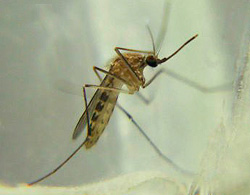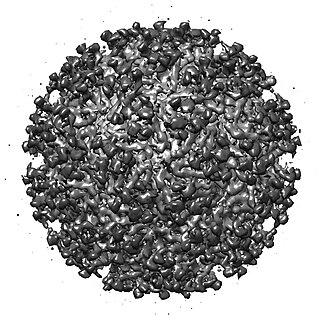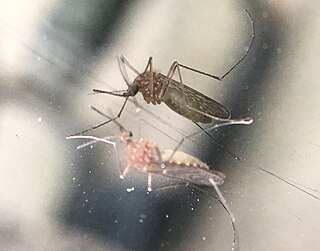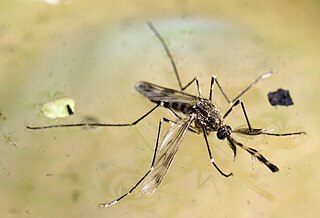
Culex is a genus of mosquitoes, several species of which serve as vectors of one or more important diseases of birds, humans, and other animals. The diseases they vector include arbovirus infections such as West Nile virus, Japanese encephalitis, or St. Louis encephalitis, but also filariasis and avian malaria. They occur worldwide except for the extreme northern parts of the temperate zone, and are the most common form of mosquito encountered in some major U.S. cities, such as Los Angeles.
Culex (Culex) tritaeniorhynchus is a species of mosquito and is the main vector of the disease Japanese encephalitis. This mosquito is a native of northern Asia, and parts of Africa. Females target large animals for blood extraction, including cattle and swine, and are strongly anthropophilic.

The discipline of medical entomology, or public health entomology, and also veterinary entomology is focused upon insects and arthropods that impact human health. Veterinary entomology is included in this category, because many animal diseases can "jump species" and become a human health threat, for example, bovine encephalitis. Medical entomology also includes scientific research on the behavior, ecology, and epidemiology of arthropod disease vectors, and involves a tremendous outreach to the public, including local and state officials and other stake holders in the interest of public safety.

Everglades virus (EVEV) is an alphavirus included in the Venezuelan equine encephalitis virus complex. The virus circulates among rodents and vector mosquitoes and sometimes infects humans, causing a febrile illness with occasional neurological manifestations. Although it is said to be rare in humans it is still debated if this is the case because of the possibility of underdiagnosing as well as being a unrecognized cause of other illnesses. The virus is named after the Everglades, a region of subtropical wetlands in southern Florida. The virus is endemic to the U.S. state of Florida, where its geographic range mirrors that of the mosquito species Culex cedecei. Hispid cotton rat and cotton mouse are considered important reservoir hosts of Everglades virus. Most clinical cases of infection occur in and around the city of Miami. The abundance in clinical cases in certain parts of Florida comes from many factors such as population density and proximity to the hosts and their ecosystem.

The London Underground mosquito is a form of mosquito in the genus Culex. It is found in the London Underground railway system as its name suggests, but has a worldwide distribution and long predates the existence of the London Underground. It was first described as a distinct species from Egyptian specimens by the biologist Peter Forsskål (1732–1763). He named this mosquito Culex molestus due to its voracious biting, but later biologists renamed it Culex pipiens f. molestus because there were no morphological differences between it and Culex pipiens. Notably, this mosquito assaulted Londoners sleeping in the Underground during the Blitz, although similar populations were long known.

Culex restuans is a species of mosquito known to occur in Canada, the United States, Mexico, Guatemala, and Honduras. It is a disease vector for St. Louis encephalitis and West Nile virus. In 2013 West Nile Virus positive specimens were collected in Southern California.

Culex annulirostris, commonly known as the common banded mosquito, is an insect native to Australia, Fiji, Micronesia, the Philippines and Indonesia. It is regarded as a serious pest species throughout its range.

Culex tarsalis, also known as Western Encephalitis Mosquito, is a mosquito species that appears in southern California. The species has black and white banding on the legs.

Culex quinquefasciatus, commonly known as the southern house mosquito, is a medium-sized mosquito found in tropical and subtropical regions of the world. It is a vector of Wuchereria bancrofti, avian malaria, and arboviruses including St. Louis encephalitis virus, Western equine encephalitis virus, Zika virus and West Nile virus. It is taxonomically regarded as a member of the Culex pipiens species complex. Its genome was sequenced in 2010, and was shown to have 18,883 protein-coding genes.
Culex modestus is a species of blood-feeding mosquito of the family Culicidae. It has been experimentally demonstrated to be capable of transmitting West Nile virus (WNV), and its habit of feeding aggressively on both birds and humans gives it significant potential for transmission of zoonotic infections from birds to humans. It is believed to be the principle bridge vector of WNV between birds and humans in southern France and is thought to have played a role in WNV transmission in the Danube delta, Caspian and Azov sea deltas, and the Volga region in Russia. It has also been implicated in Tahyna virus and Lednice virus transmission in France and Slovakia, respectively.

Aedes canadensis, the woodland pool mosquito, is an aggressive, day biting mosquito that can be a vector of a number of diseases which is found mainly in eastern North America.
Aedes vittatus is a species of mosquito that was first described in 1861 as Culex vittatus from specimens collected on Corsica. In 2000, the species was transferred to the newly erected subgenus Fredwardsius as the type species representing the subgenus.

Aedes japonicus, commonly known as the Asian bush mosquito or the Asian rock pool mosquito, was first described by Theobald in 1901 from Tokyo, Japan. They are competent arbovirus vectors known to transmit the West Nile virus as well as Japanese and St. Louis encephalitis. They are listed as an invasive species by the Global Invasive Species Database.
Mansonia (Mansonioides) annulifera is a species of zoophilic mosquito belonging to the genus Mansonia.

Culex (Culex) gelidus is a species of mosquito belonging to the genus Culex. It is found in India, Sri Lanka, Bangladesh, Cambodia, China, Hong Kong, India, Indonesia, Japan, Laos, Malaysia, Myanmar, Nepal, New Guinea (Island); Papua New Guinea, Pakistan, Philippines, Taiwan, Thailand, Vietnam. In 1976, it was identified as a major vector of Japanese encephalitis virus, in India. From an experiment, it was evident that aqueous solution of Calotropis gigantea leaves possess larvicidal activity, mosquito repellent activity and ovicidal activity against Culex gelidus.
Culex (Oculeomyia) infula is a species of mosquito belonging to the genus Culex. It is found in Bangladesh, India, Indonesia, Malaysia, Myanmar, Nepal, Philippines, Singapore, Sri Lanka, Thailand, and Vietnam. Adults mainly feeds on cattle but infrequently shows a low proportion of human and bird blood meals. Larvae can be found in water courses with high content of algal populations. In 1998, the species was identified as a vector of Japanese encephalitis virus.
Culex (Culex) pseudovishnui is a species complex of mosquito belonging to the Culex vishnui group of the genus Culex. It is found in Bangladesh, Cambodia, China, Hong Kong, India, Indonesia, Iran, Iraq, Japan, South Korea, Laos, Macau, Malaysia, Nepal, New Guinea (Island); Papua New Guinea, Pakistan, Philippines, Singapore, Sri Lanka, Thailand, Taiwan and Vietnam. It is a major vector of West Nile virus, and Japanese encephalitis virus Larvae can be found from the edges of rice fields. Adults can bite vertebrates from both indoor and outdoor places with a peak biting time on 7pm onwards.

Culiseta annulata is a species of mosquito in the family Culicidae. It is found in the Palearctic.

Culex nigripalpus is a species of medium-sized, dark, blood-feeding mosquito of the family Culicidae.

Culex torrentium is a species of mosquito in the family Culicidae. This species has a wide distribution in the temperate Palaearctic region.













